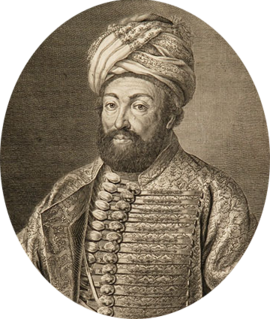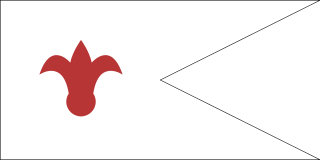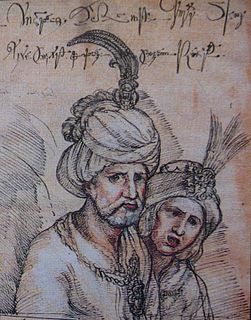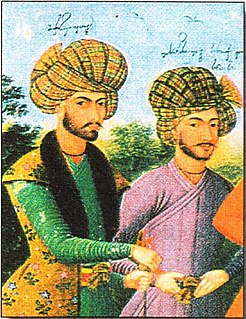Vakhtang the Good [1] (Georgian :ვახტანგ კარგი) (1738 [2] or 1742 [1] – 1 February, 1756 [2] or 1760 [1] ) was a Georgian royal prince ( batonishvili ) of the Bagrationi dynasty. He was the first child and the eldest son of Heraclius II, then-prince of Kakheti, born of his first marriage to Ketevan née Orbeliani [2] or, according to more recent research, Ketevan née Pkheidze. [1]

Georgian is a Kartvelian language spoken by Georgians. It is the official language of Georgia. Georgian is written in its own writing system, the Georgian script. Georgian is the literary language for all regional subgroups of Georgians, including those who speak other Kartvelian languages: Svans, Mingrelians and the Laz.

Georgia is a country in the Caucasus region of Eurasia. Located at the crossroads of Western Asia and Eastern Europe, it is bounded to the west by the Black Sea, to the north by Russia, to the south by Turkey and Armenia, and to the southeast by Azerbaijan. The capital and largest city is Tbilisi. Georgia covers a territory of 69,700 square kilometres (26,911 sq mi), and its 2017 population is about 3.718 million. Georgia is a unitary semi-presidential republic, with the government elected through a representative democracy.

Batonishvili is a title for royal princes and princesses who descend from the kings of Georgia from the Bagrationi dynasty and is suffixed to the names e.g. Alexandre Batonishvili, Ioane Batonishvili, Nino Batonishvili etc. The title was eventually borne not only by the children of the reigning king (mepe), but by all male-line descendants of past kings. The customary attribute or form of address for a Batonishvili was "უგანათლებულესი" (uganatlebulesi).
Vakhtang was born at the time when eastern Georgia was reconquered by the resurgent ruler of Iran Nader Shah from the Ottoman Empire and the native monarchies in both eastern Georgian kingdoms, Kartli and Kakheti, were still dormant. In 1744, Nader Shah recognized Heraclius and his father Teimuraz II as kings of Kakheti and Kartli, respectively. Thereby, Vakhtang became heir apparent to the throne of Kakheti. Furthermore, in 1747, Vakhtang was bestowed by his grandfather Teimuraz II with the fief of Aragvi, the hereditary duke ( eristavi ) of which, Bezhan, was murdered by the rebellious peasants in 1743. Henceforth, the duchy of Aragvi passed in possession of the royal family. As Vakhtang was still a minor, the duchy was run on his behalf by Prince Jimsher Cholokashvili, who had to deal with a peasant revolt and Dagestani inroads. Later, after Vakhtang's untimely death of smallpox in Tbilisi, Aragvi was granted to his half-brother, Levan. [3]

Iran, also called Persia and officially known as the Islamic Republic of Iran, is a country in Western Asia. With over 81 million inhabitants, Iran is the world's 18th most populous country. Comprising a land area of 1,648,195 km2 (636,372 sq mi), it is the second largest country in the Middle East and the 17th largest in the world. Iran is bordered to the northwest by Armenia and the Republic of Azerbaijan, to the north by the Caspian Sea, to the northeast by Turkmenistan, to the east by Afghanistan and Pakistan, to the south by the Persian Gulf and the Gulf of Oman, and to the west by Turkey and Iraq. The country's central location in Eurasia and Western Asia, and its proximity to the Strait of Hormuz, give it geostrategic importance. Tehran is the country's capital and largest city, as well as its leading economic and cultural center.
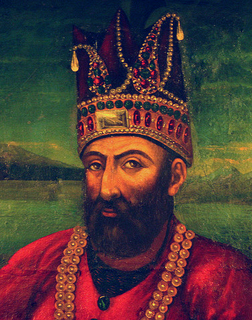
Nader Shah Afshar was one of the most powerful Iranian rulers in the history of the nation, ruling as Shah of Iran (Persia) from 1736 to 1747 when he was assassinated during a rebellion. Because of his military genius as evidenced in his numerous campaigns throughout Middle East, Caucasus, Central and South Asia, such as the battles of Herat, Mihmandust, Murche-Khort, Kirkuk, Yeghevard, Khyber Pass, Karnal and Kars, some historians have described him as the Napoleon of Persia, Sword of Persia, or the Second Alexander. Nader Shah was an Iranian who belonged to the Turkmen Afshar tribe of Khorasan in northeastern Iran, which had supplied military power to the Safavid dynasty since the time of Shah Ismail I.

The Ottoman Empire, historically known in Western Europe as the Turkish Empire or simply Turkey, was a state that controlled much of Southeast Europe, Western Asia and North Africa between the 14th and early 20th centuries. It was founded at the end of the 13th century in northwestern Anatolia in the town of Söğüt by the Oghuz Turkish tribal leader Osman I. After 1354, the Ottomans crossed into Europe, and with the conquest of the Balkans, the Ottoman beylik was transformed into a transcontinental empire. The Ottomans ended the Byzantine Empire with the 1453 conquest of Constantinople by Mehmed the Conqueror.
Vakhtang was married to Ketevan (20 February 1744–4 March 1808), daughter of Constantine III, Prince of Mukhrani. They had no children. Princess Ketevan lived to see the demise of the Georgian kingdom at the hand of the Russian Empire in 1801 and died in St. Petersburg in 1808. [2]
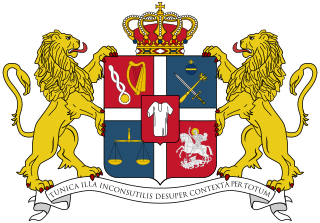
The House of Mukhrani is a Georgian family, a branch of the former royal dynasty of Bagrationi from which it sprang early in the 16th century, and received in appanage the domain of Mukhrani located in Kartli, central Georgia. The family has since been known as Mukhran-Batoni, that is, "Princes (batoni) of Mukhrani".

The Russian Empire, also known as Imperial Russia or simply Russia, was an empire that existed across Eurasia and North America from 1721, following the end of the Great Northern War, until the Republic was proclaimed by the Provisional Government that took power after the February Revolution of 1917.



